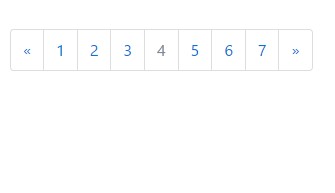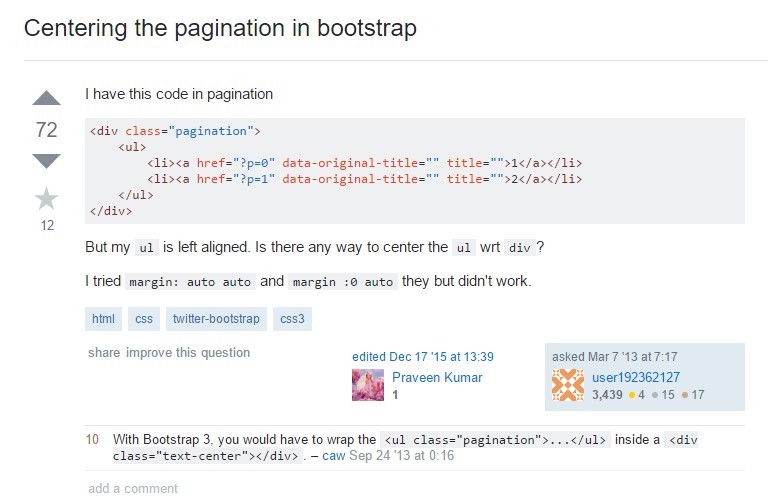Bootstrap Pagination Tutorial
Overview
An upward trend in the front-end world is the use of CSS frameworks with base styles for our page. Instead of starting every project from scratch, creating every style in the hand, there are frameworks that already bring a whole built base from where we will start our application.
Bootstrap offers a variety of functions:
● Totally reset CSS
● Basis graphical design for most tags
● Icons.
● Grids ready for apply.
● CSS Elements.
● JavaScript Plugins.
● All mobile-first and responsive .
As its name proposes, it is a way to start off the project shortly with a basic style and elements without losing design time in the starting point.
Important pagination concepts.
When we have a web page having numerous items to show, paging becomes necessary. We understand that in the case of checklists, such as showing products in internet stores or even search results in systems, the need is not to expose all objects at one time, but alternately to set up them effectively, preparing them easier to get access to, much faster and more standard web pages.
Below are some very good methods in the use of Bootstrap Pagination, despite the technology chosen ( get more info)
Pagination: an additional title.
Paging dispenses the title when well designed. That is , if you had to write "Pagination" for the user of Bootstrap Pagination Table to apply, there is some thing incorrect: look into redesigning it!
Great exposure and positioning.
Paging is a complementary navigation and should really come with really good placing and really good visibility. Use fonts with sizings and color tones that follow the style of page usage, giving very good presence and locating it directly after the object listing ends.
Be practical.
Some paging instruments use complicated navigating features for example, going straightaway to a certain webpage or perhaps developing a certain number of pages at one time. Despite the fact they are additional features, users are more adapted to basic forms and do much better with usual styles.
Bring sorting options.
A good and highly recommended capability is to bring sorting methods to improve their usage.
Do not make use of subscript designs on urls.
In paging tools, all of these capabilities are unneeded, considering that the urls are clear and the subscript format will just keep the visual loaded. ( more hints)
Deliver desirable zone for clickable local areas.
The bigger the clickable space the much more available the tabs get and because of this much easier to use.
Deliver zones in between web links
Territory from one button to yet another will make paging more convenient and user-friendly , keeping away from unwanted access.
Determine the present page and provide the fundamental site navigation urls.
The paging work is to assist in user site navigation, so the device should really keep it clear precisely where the user is, where exactly he has been and where he can go on.
Produce helpful site navigation urls just like "Previous Page" and "Next Page", always placing them at the starting point and finish.
Deliver helpful shortcuts and supplementary information
Links to the "first page" and "last page" are frequently helpful, think about them if it is necessary!
Apply a wrapping
<nav>In addition, as webpages likely have more than one such navigation section, it's smart to present a detailed
aria-labelaria-label="Search results pages"<nav aria-label="Page navigation example">
<ul class="pagination">
<li class="page-item"><a class="page-link" href="#">Previous</a></li>
<li class="page-item"><a class="page-link" href="#">1</a></li>
<li class="page-item"><a class="page-link" href="#">2</a></li>
<li class="page-item"><a class="page-link" href="#">3</a></li>
<li class="page-item"><a class="page-link" href="#">Next</a></li>
</ul>
</nav>Bootstrap Pagination
Basic Bootstrap Pagination Example
Supposing that you have a internet site with many pages, you may perhaps wish to add some form of pagination to every page.
To set up a basic pagination, put in the
.pagination<ul>
<nav>
<ul class="pagination">
<li class="page-item">
<a href="#" class="page-link" aria-label="Previous">
<span aria-hidden="true">«</span>
</a>
</li>
<li class="page-item"><a href="#" class="page-link">1</a></li>
<li class="page-item"><a href="#" class="page-link">2</a></li>
<li class="page-item"><a href="#" class="page-link">3</a></li>
<li class="page-item"><a href="#" class="page-link">4</a></li>
<li class="page-item"><a href="#" class="page-link">5</a></li>
<li class="page-item"><a href="#" class="page-link">6</a></li>
<li class="page-item"><a href="#" class="page-link">7</a></li>
<li class="page-item">
<a href="#" class="page-link" aria-label="Next">
<span aria-hidden="true">»</span>
</a>
</li>
</ul>
</nav>Bootstrap 4 and Bootstrap 3 characteristics
Bootstrap 3 only demands the
.paginationBootstrap 4, besides the
.pagination.page-item<li>.page-link<a>Working with icons
Planning to apply an icon or symbol instead of words for a number of pagination links? Be sure to provide appropriate screen reader support with
aria.sr-only<nav aria-label="Page navigation example">
<ul class="pagination">
<li class="page-item">
<a class="page-link" href="#" aria-label="Previous">
<span aria-hidden="true">«</span>
<span class="sr-only">Previous</span>
</a>
</li>
<li class="page-item"><a class="page-link" href="#">1</a></li>
<li class="page-item"><a class="page-link" href="#">2</a></li>
<li class="page-item"><a class="page-link" href="#">3</a></li>
<li class="page-item">
<a class="page-link" href="#" aria-label="Next">
<span aria-hidden="true">»</span>
<span class="sr-only">Next</span>
</a>
</li>
</ul>
</nav>Active condition
The active state shows what the present webpage is.
Add
.active
<nav>
<ul class="pagination">
<li class="page-item">
<a href="#" class="page-link" aria-label="Previous">
<span aria-hidden="true">«</span>
</a>
</li>
<li class="page-item"><a href="#" class="page-link">1</a></li>
<li class="page-item"><a href="#" class="page-link">2</a></li>
<li class="page-item"><a href="#" class="page-link">3</a></li>
<li class="page-item active"><a href="#" class="page-link">4</a></li>
<li class="page-item"><a href="#" class="page-link">5</a></li>
<li class="page-item"><a href="#" class="page-link">6</a></li>
<li class="page-item"><a href="#" class="page-link">7</a></li>
<li class="page-item">
<a href="#" class="page-link" aria-label="Next">
<span aria-hidden="true">»</span>
</a>
</li>
</ul>
</nav>Disabled Form
A disabled url can not be moused click:
If a url for some reason is disabled, add
.disabled
<nav>
<ul class="pagination">
<li class="page-item">
<a href="#" class="page-link" aria-label="Previous">
<span aria-hidden="true">«</span>
</a>
</li>
<li class="page-item"><a href="#" class="page-link">1</a></li>
<li class="page-item"><a href="#" class="page-link">2</a></li>
<li class="page-item"><a href="#" class="page-link">3</a></li>
<li class="page-item disabled"><a href="#" class="page-link">4</a></li>
<li class="page-item"><a href="#" class="page-link">5</a></li>
<li class="page-item"><a href="#" class="page-link">6</a></li>
<li class="page-item"><a href="#" class="page-link">7</a></li>
<li class="page-item">
<a href="#" class="page-link" aria-label="Next">
<span aria-hidden="true">»</span>
</a>
</li>
</ul>
</nav>Pagination Sizes
Paging blocks can as well be proportioned to a bigger or much smaller size.
Add
.pagination-lg.pagination-sm
<nav>
<ul class="pagination pagination-lg">
<li class="page-item">
<a href="#" class="page-link" aria-label="Previous">
<span aria-hidden="true">«</span>
</a>
</li>
<li class="page-item"><a href="#" class="page-link">1</a></li>
<li class="page-item"><a href="#" class="page-link">2</a></li>
<li class="page-item"><a href="#" class="page-link">3</a></li>
<li class="page-item"><a href="#" class="page-link">4</a></li>
<li class="page-item"><a href="#" class="page-link">5</a></li>
<li class="page-item"><a href="#" class="page-link">6</a></li>
<li class="page-item"><a href="#" class="page-link">7</a></li>
<li class="page-item">
<a href="#" class="page-link" aria-label="Next">
<span aria-hidden="true">»</span>
</a>
</li>
</ul>
</nav>
<nav>
<ul class="pagination">
<li class="page-item">
<a href="#" class="page-link" aria-label="Previous">
<span aria-hidden="true">«</span>
</a>
</li>
<li class="page-item"><a href="#" class="page-link">1</a></li>
<li class="page-item"><a href="#" class="page-link">2</a></li>
<li class="page-item"><a href="#" class="page-link">3</a></li>
<li class="page-item"><a href="#" class="page-link">4</a></li>
<li class="page-item"><a href="#" class="page-link">5</a></li>
<li class="page-item"><a href="#" class="page-link">6</a></li>
<li class="page-item"><a href="#" class="page-link">7</a></li>
<li class="page-item">
<a href="#" class="page-link" aria-label="Next">
<span aria-hidden="true">»</span>
</a>
</li>
</ul>
</nav>
<nav>
<ul class="pagination pagination-sm">
<li class="page-item">
<a href="#" class="page-link" aria-label="Previous">
<span aria-hidden="true">«</span>
</a>
</li>
<li class="page-item"><a href="#" class="page-link">1</a></li>
<li class="page-item"><a href="#" class="page-link">2</a></li>
<li class="page-item"><a href="#" class="page-link">3</a></li>
<li class="page-item"><a href="#" class="page-link">4</a></li>
<li class="page-item"><a href="#" class="page-link">5</a></li>
<li class="page-item"><a href="#" class="page-link">6</a></li>
<li class="page-item"><a href="#" class="page-link">7</a></li>
<li class="page-item">
<a href="#" class="page-link" aria-label="Next">
<span aria-hidden="true">»</span>
</a>
</li>
</ul>
</nav>Switch the positioning of pagination components by using flexbox utilities.

<nav aria-label="Page navigation example">
<ul class="pagination justify-content-center">
<li class="page-item disabled">
<a class="page-link" href="#" tabindex="-1">Previous</a>
</li>
<li class="page-item"><a class="page-link" href="#">1</a></li>
<li class="page-item"><a class="page-link" href="#">2</a></li>
<li class="page-item"><a class="page-link" href="#">3</a></li>
<li class="page-item">
<a class="page-link" href="#">Next</a>
</li>
</ul>
</nav>
<nav aria-label="Page navigation example">
<ul class="pagination justify-content-end">
<li class="page-item disabled">
<a class="page-link" href="#" tabindex="-1">Previous</a>
</li>
<li class="page-item"><a class="page-link" href="#">1</a></li>
<li class="page-item"><a class="page-link" href="#">2</a></li>
<li class="page-item"><a class="page-link" href="#">3</a></li>
<li class="page-item">
<a class="page-link" href="#">Next</a>
</li>
</ul>
</nav>Examine several on-line video training relating to Bootstrap Pagination
Connected topics:
Bootstrap pagination approved documentation

W3schools:Bootstrap pagination tutorial

Centering the pagination in Bootstrap

